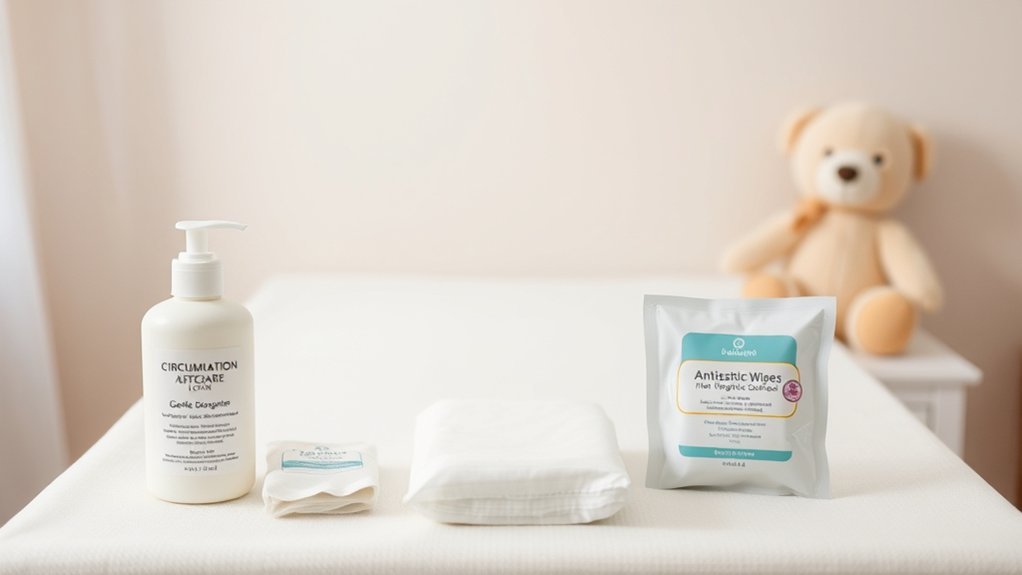After your circumcision, managing pain and ensuring proper healing is vital. Many find that over-the-counter medications can help alleviate discomfort effectively. It’s important to keep the area clean without using soap for the first week. However, knowing what signs to watch for can make a significant difference in your recovery process. Are you aware of what constitutes a red flag during this time? Let’s explore the essential do’s and don’ts for ideal aftercare.
Managing Pain Effectively
When you’ve undergone circumcision, managing pain effectively is vital for your recovery. You’ll likely experience discomfort in the days following the procedure, and addressing it promptly can enhance your healing. Over-the-counter pain relievers, such as ibuprofen or acetaminophen, can alleviate pain and reduce inflammation. Always follow your healthcare provider’s recommendations regarding dosages and timing. Applying a cold compress to the area can also provide relief, but avoid direct contact with the skin. It’s important to rest and avoid activities that strain the healing area. Keep an eye on your pain levels; if they persist or worsen, reach out to your healthcare professional. Prioritizing pain management helps guarantee a smoother recovery and promotes overall well-being during this sensitive time.
Keeping the Area Clean
Pain management is just one aspect of your recovery process; keeping the area clean is equally important to prevent infection and promote healing. Gently wash the area with warm water daily, avoiding soap for the first week, as it can irritate the sensitive skin. Pat the area dry with a clean, soft towel—don’t rub. You should also keep the surgical site free from any irritants, including tight clothing. If you notice any crusting, it’s okay to use a damp cloth to carefully clean it away. Change your bandage as directed, ensuring you use sterile materials. Staying diligent about cleanliness will greatly aid in your recovery, allowing your body to heal effectively. Always consult your healthcare provider if you have questions or concerns.
Recognizing Signs of Infection
Although most recoveries proceed smoothly, it’s crucial to be vigilant for signs of infection after circumcision. Watch for increased redness or swelling around the surgical site, as these can indicate inflammation. If you notice discharge that’s yellow or green, it may signal an infection. Pay attention to any unusual odor coming from the area, which can also be a red flag. Additionally, a persistent fever or increased pain not alleviated by over-the-counter medications warrants immediate medical attention. It’s important to trust your instincts—if something doesn’t seem right, don’t hesitate to consult a healthcare professional. Early detection can lead to effective treatment and promote a smoother recovery. Your well-being is the priority.
Avoiding Irritation and Injury
To guarantee a smooth recovery after circumcision, it’s essential to minimize irritation and prevent injury to the surgical site. Follow these guidelines to ascertain comfort and proper healing:
To ensure a smooth recovery from circumcision, minimize irritation and follow essential healing guidelines.
- Wear Loose Clothing: Opt for breathable, loose-fitting underwear to reduce friction and allow airflow.
- Avoid Sexual Activity: Refrain from any sexual activities until fully healed to prevent unnecessary stress on the area.
- Limit Physical Activity: Steer clear of vigorous exercise or activities that may cause sweating or chafing around the surgical site.
- Keep the Area Clean: Gently wash the area daily with mild soap and water, avoiding any harsh chemicals or scrubbing.
When to Seek Medical Attention
How can you tell if your recovery is going smoothly, or if something’s amiss? Pay close attention to any unusual symptoms. If you notice excessive swelling, persistent bleeding, or an unusual discharge, it’s time to seek medical attention. Pain that escalates rather than improves could signal an infection, requiring prompt evaluation by a healthcare professional. Additionally, if you experience a fever over 101°F or feel generally unwell, don’t hesitate to reach out. While some discomfort is normal, you shouldn’t ignore signs that indicate complications. Remember, your well-being is paramount, so trusting your instincts and consulting a doctor can help guarantee a smoother recovery. Prioritize your health and don’t wait too long to ask for help if needed.
Frequently Asked Questions
Can I Use Baby Wipes for Cleaning After Circumcision?
You shouldn’t use baby wipes right after circumcision, as they often contain alcohol or fragrances that can irritate the sensitive area. Instead, gently clean with mild soap and water to promote healing and comfort.
What Activities Should Be Avoided During Recovery?
During recovery, you should avoid vigorous activities, such as running or jumping, and refrain from swimming or soaking in water. These actions can irritate the area, potentially leading to complications and delaying healing.
How Long Does the Circumcision Healing Process Take?
Healing typically takes about one to two weeks, but individual recovery times vary. You should monitor for any signs of infection and follow your healthcare provider’s advice to guarantee a smooth healing process.
Is It Normal for the Area to Smell After Surgery?
It’s not uncommon for the area to have a slight odor after surgery; studies show about 30% of patients experience this. As healing progresses, the smell typically diminishes, so don’t worry too much.
Can I Apply Ointment or Cream on the Incision Site?
You shouldn’t apply ointment or cream on the incision site unless your healthcare provider specifically recommends it. Keeping the area clean and dry is essential for proper healing and preventing infection. Always follow your doctor’s guidance.
Conclusion
In summary, following proper circumcision aftercare is essential for a smooth recovery. You might worry about discomfort or the healing process taking too long, but envision your body gradually restoring itself, allowing you to return to your normal activities with confidence. By managing pain, keeping the area clean, and monitoring for signs of infection, you can promote healing effectively. Remember, if you have any concerns, don’t hesitate to reach out to your healthcare professional for guidance and support.
